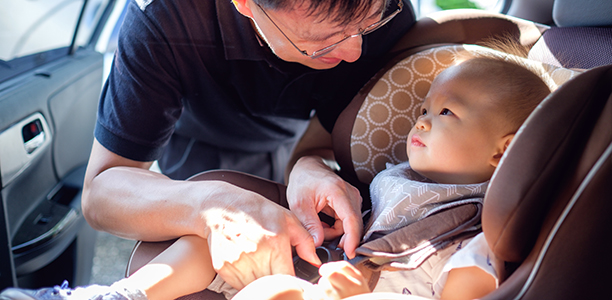Why should you restrain your child in a car seat?
Once the car seat is installed, you will need to fit your child securely in it every time they ride in the car. A restraint or harness will not offer the best protection for your child unless it is fitted properly. It has been shown that children who are optimally restrained are over three times less likely to sustain an abdominal injury in an accident than children who are not optimally restrained. Children aged 2-5 years who were restrained with a seatbelt are over 4 times more likely to sustain a significant head injury than children properly restrained in a child restraint.
Always make sure the child restraint is still installed properly
Before you sit your child in the seat, check that the seat belt holding the restraint in place is correctly buckled. Do this every time you put your child in their car seat or capsule.
Check your child still fits properly in the restraint
Some car seats have several slots for the harness shoulder straps, to accommodate child growth. As your child grows, regularly check that the strap slot being used is still the best height. For forward facing restraints, the right one to use is the one nearest to your child’s shoulder height (and never more than 2.5 cm below their shoulders). For rearward facing restraints, use the slot nearest to the shoulders, but not below them.
Your child should fit comfortably in the seat. If they have outgrown the car seat, upgrade them to a different type of car seat even if they are not yet the correct age for that seat. Body size is more important than age when it comes to sitting safely in a car seat. You should never use a car seat that is too big for your child.
Fastening the harness or belt
When securing your child in a rear or forward facing restraint or a booster seat, always follow the manufacturer’s instructions.
For forward facing restraints with harnesses, tighten the straps so that they sit above your child’s shoulders but below their ears. The straps should rest flat on your child’s body and tight enough so that you cannot pinch them. Always check that they are not hooked or caught on something.
For children in a booster seat, ensure that the sash belt is positioned over their shoulder, in the correct position for the seat. Follow the seat belt path according to the manufacturer’s instructions. The lap section of the belt should sit low on your child’s hips.
Always wear your own seat belt and make sure everyone else in the car is wearing their seat belt. It sets a good example for young children who might take some time to get used to being restrained in a car seat. Remember that although they are not legally required to use a car seat after the age of seven, most kids don’t fit properly into an adult-sized seat belt until they are twelve years old. It is recommended that they continue using a car seat until they are 145cm tall.
Travelling accessories
Toys
When you are travelling you may like to offer your child toys to keep them entertained for the journey. Ensure they only play with soft toys which cannot injure them during the impact of a car accident. Avoid hard toys and particularly those with sharp or rough surfaces.
Sun shades
Anything that may cover the child or restraint, such as sun shades or insect nets, are not recommended as they could make it more difficult to get to the child in the case of an emergency.
Child restraints on buses and taxis
When children are riding on public buses they do not need to use a child restraint but they should be seated in their own seat on the bus. In taxis and rental cars, it is recommended that children use an age-appropriate child restraint whenever available.
Teach your child to travel in a car seat
Using a buckle cover or other device to stop your child unbuckling their seat belt is not recommended. It will also make it more difficult for you to remove their seat belt quickly if you need to. Instead, spend time while they’re young teaching them to travel without fiddling with their seat belt buckle.
References
- Tasmanian Government. Child restraints: A guide to car seats. 2015 (cited 30 July 2015). Available from: [URL link]
- Government of South Australia. Road rules: Seat belts and child restraints. 2015 (cited 10 August 2015). Available from: [URL link]
- Nance ML, Lutz N, Arbogast KB, et al. Optimal restraint reduces the risk of abdominal injury in children involved in motor vehicle crashes. Ann Surg. 2004;239(1):127-31. [Full text]
- Winston F, Durbin D, Kallan M, et al. The danger of premature graduation to seat belts for young children. 2000;105(6):1179-83. [Abstract]
- Neuroscience Research Australian and Kidsafe. Best practice guideline for the safe restraint of children travelling in motor vehicles. 2013 (cited 13 August 2015). Available from: [URL link]
- NSW Transport. Using a car seat correctly. 2015 (cited 13 August 2015). Available from: [URL link]
- Vic Roads. Frequently asked questions about child restraints. 2015 (cited 30 July 2015). Available from: [URL link]
- New South Wales Government. Child car seats. 2015 (cited 30 July 2015). Available from: [URL link]



 (6 votes, average: 4.33 out of 5)
(6 votes, average: 4.33 out of 5) 






